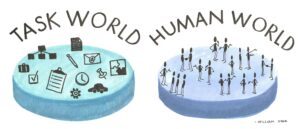
Leading Through Fear and Uncertainty
HR has been here before. Back in 2021 Naveen Bhateja, chief people officer and executive vice president of Medidata Solutions, said, “HR has cemented its position as the right hand of the CEO, helping navigate complex people-centric challenges.”
Despite the overwhelm and chaos that ensued during the pandemic, it also created the desire for more CHROs and HR leadership, something that has been overdue for years. ICE raids, layoffs, and an uptick in natural disasters are calling for that leadership once again. “People-centric challenges”—or human issues that are largely downplayed until they affect the bottom line—will become more prevalent in the future.
Brian Tarallo of Lizard Brain facilitates for many employers across the U.S.; he says the major theme in the rooms right now is fear and uncertainty. This confusion is caused by the abrupt changes of this new administration. Employers feel they don’t have clear guidance from the government on high stake issues.
Federal workers, for example, are caught in buyout programs. Some employees working overseas through USAID don’t have access to funds to travel home. Abrupt changes to your employees’ or their families’ livelihoods can cause panic. This is where HR can step in to help create a culture of calm in crisis.
Strong HR leadership requires that you take hold of the wheel and steer the ship. Some of us are born to do this work…and then there are the rest of us who don’t know how, exactly, we’re supposed to lead. More than ever, HR departments need leadership tools.
Face the Fear
The first step to building a leadership practice is to determine what kind of leader you are. An authentic approach is one of the fundamental requirements for meaningful leadership. There are a variety of leadership styles: some are laissez-faire, others are bureaucratic, coaching, transformational, visionary, or transactional. According to John C. Maxwell in The 21 Irrefutable Laws of Leadership, the best way to figure out your leadership style is to start with your innate character. Who are you as a person? What do you value most? Leading from your truest place can inspire buy-in, which is always necessary to influence.
In defining your leadership style, it can be helpful to think about past experiences. In our recent webinar on Learn, Lift, Lead: How to Think, Act, and Inspire Your Way to Greatness, author Wendy Ryan spoke about how to use storytelling to future-proof leadership. Using storytelling, we can build our credibility, our reputation, and help our organization remember key details.
What was it like for your organization going through Covid? What happened when Trump was elected in 2016? Reminding employees about the challenges your organization overcame can be one of the most effective ways to calm their anxieties in times of uncertainty.
It’s natural to avoid difficult emotions. But to effectively navigate high stakes issues as a leader, you need to focus on addressing the emotion of your organization. Many HR leaders feel caught between the seemingly competing priorities of task productivity and employee wellbeing.
This is something of a false dichotomy. One of the best ways to promote productivity is to create a work culture where employees feel respected and heard. Without a balance between compliance and advocacy, you can expect employee disengagement, lower productivity levels, and turnover.
SHRM says, “In many ways, the pandemic renewed the emphasis on the people part of HR’s job. Without focusing on supporting and advocating for employees, or the people part of the job, you lose the revenue. Without transparency and reassurances to relieve anxiety, it can cause a trickle-down effect to engagement, productivity, and absenteeism.
Although the HR department is still responsible for the performance, productivity and efficiency of the workforce, Brian Kropp, group vice president and chief of research in the HR practice at Gartner says, “Our bigger job is to understand the challenges our employees face, what they are struggling with inside and outside of work.”
When I explained to another consultant how people problems are often the root cause for workplace issues, he scoffed, saying those are just “soft skills.” To him, soft skills are just that, “soft,” and therefore “unimportant.” But to be successful, HR leaders need to strike a balance between tasks and the human element. You need both soft and hard skills.
That’s why it’s important to focus on employee emotions during times of fear and uncertainty. Transparency and clear, simple communication can help combat fear. When you validate what everyone is experiencing, you instill trust and create a calm culture, agile enough to handle abrupt change.
Proactively Prepare to Combat Fear
In his 21 Irrefutable Laws of Leadership, Maxwell says to think of yourself as the captain of the ship, charting the route across the ocean. What’s the vision? How will you navigate the path across the waters? Most importantly, how do you want everyone to feel if the unexpected occurs? To fight fear, you have to start by being prepared yourself to convey an authentic calm demeanor.
Take the U.S. Immigration and Customs Enforcement (ICE) raids, for example: taking a proactive approach means developing your ICE Workplace Raid Response Plan. This includes a template to train your employees, guidance on what to do if ICE shows up, and information on employees’ rights.
Creating a training isn’t enough, though. Full transparency involves creating an email campaign (or other communication plan) and an FAQ to help your employees navigate the storm.
While things can change fast in the federal government, adjusting to a flexible mindset and flexible preparation can help you feel ready for anything. If you need help preparing look to other states. If a law is enacted in another state, there are resources available to ensure you’re covering your bases. Stay informed and see how workplaces in different states are preparing. For example, when creating our Workplace Raid Response Plan, we looked at ICE raids in New Jersey.
Create an Internal Plan to Ease Your Anxiety
While ICE raids could impact employees, HR departments will also be affected. FordHarrison says that when it comes to ICE raids, you’ll want to document good faith efforts. We know from Trump’s last term that we can expect I-9 audits. Back in 2017, during the first Trump administration, ICE dramatically ramped up I-9 audits from about 1,360 in fiscal year 2017 to nearly 6,000 in fiscal year 2018 and 6,450 in fiscal year 2019. You should start an I-9 audit immediately, especially if you’re in construction, agriculture, or manufacturing.
In times of uncertainty, employees look to leadership for guidance and information. Keeping employees updated establishes internal credibility and helps everyone stay calm. Developing a plan for yourself also goes a long way toward helping to maintain a calm atmosphere.
The information contained in this site is provided for informational purposes only, and should not be construed as legal advice on any subject matter.

Advice in Your Inbox
Join our newsletter for free bi-monthly toolkits and downloads on how to hire, support, and retain your best talent.







